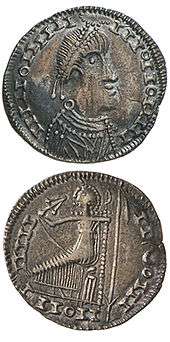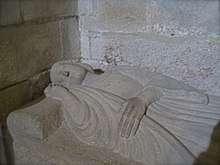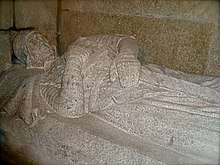List of Galician monarchs
Galicia is an autonomous community and historical nationality in modern-day northwestern Spain on the Iberian Peninsula, which was and continues to be a major part of the Roman province known as Gallaecia prior to 409. It consists of the provinces of A Coruña, Lugo, Ourense and Pontevedra. It is bounded on the north by the Cantabrian Sea, to the south by Portugal, to the west by the Atlantic Ocean and to the east by principality of Asturias and the community of Castile and León. The archipelago of the Cíes Islands, the Ons archipelago, the Sálvora archipelago and other island such as Cortegada, Arousa, the Sisargas Islands and the Malveiras Islands are also part of Galicia.
the Iberian Peninsula |
| al-Andalus |
| Almohads |
| Almoravids |
Aragon
|
| Asturias |
Castile
|
| Catalonia |
| Córdoba Emirate · Caliphate
|
| Galicia |
| Granada |
| León |
| Majorca |
Navarre
|
Portugal
|
| Spain Medieval · Modern
|
| Suebi |
| Taifas |
| Valencia |
| Viguera |
| Visigoths |
Galicia has about 2,795,422 inhabitants which mainly combines the coastal strip between Ferrol and A Coruña in the northwest and between Vilagarcía de Arousa and Vigo in the southwest.
The medieval and modern Kingdom of Galicia derived of the kingdom of the Suebi, founded by king Hermeric in 409. By the 6th century the kingdom of the Suebi was already known as Kingdom of Galicia, Gregory of Tours being the first chronicler to use this denomination.[1]
Suebic Kings of Galicia (409–585)

First Royal Dynasty (409–456)
Kings during a Suebic Civil War (457–469) Note: the civil war split the kingdom, and multiple kings ruled smaller regions of Galicia.
- Maldras (457–460)
- Framta (457)
- Richimund (457–464)
- Frumar (460–464)
- Remismund (464–469) - reunification
Dark Period (469–550)
Final Suevic Period (550–585)
Visigothic Kings of Galicia, Hispania and Septimania
The Visigoth kings took control of Galicia in 585, which became the sixth province of the Kingdom of Toledo. Anyhow, Galicia maintained a distinguishable administrative and legal identity up to the collapse of the Visigothic monarchy:
- Liuvigild (585–586)
- Reccared I (586–601)
- Liuva II (601–603)
- Witteric (603–610)
- Gundemar (610–612)
- Sisebut (612–621)
- Reccared II (621)
- Suintila (621–631)
- Sisenand (631–636)
- Chintila (636–640)
- Tulga (640–641)
- Chindasuinth (641–653)
- Reccesuinth (649–672)
- Wamba (672–680)
- Erwig (680–687)
- Egica, (687–702) - secured his son Wittiza as his heir
- Wittiza (694-710) - associated to the throne as king in Galicia until 702; only king after his father's death
- Roderic (710–712)
From the fall of the Visigothic kingdom until the beginning of the 10th century, Galicia was integrated with other Christian kingdoms of the Iberian peninsula (Kingdom of Asturias and Kingdom of León).
Kings of Galicia
In 910, Alfonso III the Great was forced to abdicate in favor of his sons, who partitioned the kingdom. This resulted in a briefly independent kingdom of Galicia:
- Ordoño II (910–914)
In 914, Ordoño acquired the throne at León, reuniting his father's kingdom. On the death of his brother Fruela II of León in 925, there was a period of competing claimants, being made king in Galicia:
- Sancho I Ordóñez (926–929), first-born of Ordoño II
The death of Sancho led to Galicia again becoming part of the Kingdom of León, with which it was joined until 982, when the Galician nobility crowned in Santiago de Compostela an anti-king:
- Bermudo II (982–985)
Bermudo routed Ramiro III of León in the battle of Portela de Areas, later becoming undisputed ruler of the Leonese kingdom, and so reunifying the realm.
Jiménez dynasty (1037–1111)
Upon the death of Ferdinand I of León and Castile in 1065, Castile, León, and Galicia became three separated kingdoms:
- García II (1065–1072) - reigned in Galicia and Portugal until deposed by his brother Alfonso in 1072, after which he was kept chained in a castle until his death in 1090.
Alfonso VI of León reunited the Kingdoms of Castile, León and Galicia.
House of Burgundy
- Alfonso VII (1111–1157) – In 1111 he was crowned as the mediatized king of Galicia in Santiago de Compostela as his mother's heir apparent, and in 1126 he succeeded Urraca as king of León, Castile and Toledo. Galicia was again merged within the larger realm, its size reduced in 1139 when Afonso Henriques won the independence of the County of Portugal. From 1152 on Alfonso VII associated his sons to the throne, Ferdinand receiving the title of King of Galicia. On the death of his father, in 1157, Fernando became King of León.
- Ferdinand II, king of León (1157–1188) and Galicia (1152–1188)
He was succeeded by his son:
- Alfonso IX, king of León and Galicia (1188–1230)
On his death, he divided the kingdom between his daughters, who reigned a few months de jure:
- Dulce, queen of Galicia (1230) de jure
With the accession to the throne of Ferdinand III of Castile in 1230, the Kingdom of Galicia became dynastically united with the kingdoms of León, Castile and Toledo inside the Crown of Castile, but maintaining its personality as a kingdom, and its own legal institutions.
During the early reign Ferdinand IV, his uncle disputed the title with him and claimed to be king of León, Galicia and Seville
- John of Castile, Lord of Valencia de Campos, titular king of León, Galicia and Seville (1296-1300)
Portuguese House of Burgundy
Following Peter I of Castile's death, a succession crisis occurred. During this time, the throne of Galiza was offered to Ferdinand I of Portugal, a member of the Portuguese House of Burgundy, and he was acclaimed in Galiza as King. His reign would see the opening of trade between the two nations and economic benefits for both. This reign, however, would be short, once Henry II of Castile demanded that Ferdinand give up the throne to Castile. Ferdinand did so easily, having not seen Galicia as an integral part of the Portuguese nation.
English House of Lancaster
In 1386, John of Gaunt pressed the claim for his wife (and himself), to the throne of Castile. He successfully invaded Galicia and held most of the country until he was defeated in 1387.
Portuguese House of Avis
Afonso V of Portugal and Juana la Beltraneja, acclaimed de jure kings of Galicia in 1475, saw their pretensions to the Castilian throne defeated at the Battle of Toro in 1479.
 Sepulcher of count Raymond of Burgundy, lord of Galicia, and father of Alfonso VII (d. 1107)
Sepulcher of count Raymond of Burgundy, lord of Galicia, and father of Alfonso VII (d. 1107).jpg) Sepulcher of king Ferdinand II (d. 1187)
Sepulcher of king Ferdinand II (d. 1187) Sepulcher of king Alfonso IX (d. 1230)
Sepulcher of king Alfonso IX (d. 1230) Sepulcher of count Pedro Fróilaz de Traba, protector of king Alfonso VII (d. 1128)
Sepulcher of count Pedro Fróilaz de Traba, protector of king Alfonso VII (d. 1128)
References
Notes
- "Quo defuncto, filius eius Eurichus Leuvichildi regis amicitias expetiit, dataque, ut pater fecerat, sacramenta, regnum Galliciensim suscepit. Hoc vero anno cognatus eius Audica, qui sororem illius disponsatam habebat, cum exercitu venit; adpraehensumque clericum facit ac diaconatus sibi praesbiterii ei inponi honorem iobet. Ipse quoque acceptam soceri sui uxorem, Galliciensim regnum obtenuit." Gregory of Tours, Historiarum, VI.43.
Bibliography
- Carballeira Debasa, Ana María (2007). Galicia y los gallegos en las fuentes árabes medievales. Madrid: Consejo Superior de Investigaciones Cientifícas. ISBN 978-84-00-08576-6. (in Spanish)
- De la Gándara, Felipe (1677): Nobiliario, armas, y triunfos de Galicia". Julian de Paredes, Madrid. (in Spanish)
- Fletcher, Richard. A (1984): Saint James's catapult: the life and times of Diego Gelmírez of Santiago de Compostela. ISBN 978-0-19-822581-2. (in English)
- García Oro, José (1987): Galicia en los siglos XIV y XV. Fundación "Pedro Barrie de la Maza, Conde de Fenosa", A Coruña. ISBN 84-85728-59-9. (in Spanish)
- González López, Emilio (1978): Grandeza e Decadencia do Reino de Galicia. Galaxia, Vigo. ISBN 84-7154-303-6. (in Galician)
- López Carreira, Anselmo (2005): O Reino medieval de Galicia. A Nosa Terra, Vigo. ISBN 978-84-8341-293-0 (in Galician)
- Portela Silva, Ermelindo (2001): "García II de Galicia, el rey y el reino (1065-1090)". La Olmeda, Burgos. ISBN 84-89915-16-4. (in Spanish)
- Rodríguez Fernández, Justianiano (1997): García I, Ordoño II, Fruela II, Alfonso IV. Editorial La Olmeda, Burgos. ISBN 84-920046-8-1. (in Spanish)
- Thompson, E. A. (2002): Romans and barbarians: the decline of the Western Empire. Univ of Wisconsin Press. ISBN 978-0-299-08704-3. (in English)
- Torres Rodríguez, Casimiro (1977): El Reino de los Suevos. Fundación Barrié de la Maza, A Coruña. ISBN 84-85319-11-7. (in Spanish)
- Villacañas Berlanga, José Luis (2006) La formación de los reinos hispánicos. Pozuelo de Alarcón: Espasa Calpe. ISBN 84-670-2257-4. (in Spanish)
See also
|
|
|